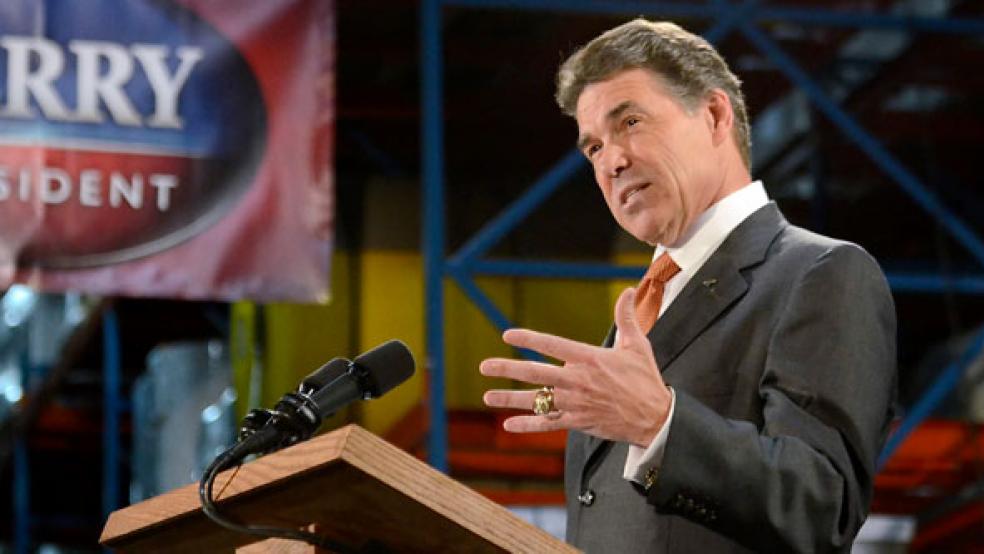Suddenly, Herman Cain’s 9-9-9 plan isn’t the only sweeping tax code overhaul on the block. This morning, Texas Gov. Rick Perry tossed his own flat-tax proposal into the GOP ring, and according to tax experts, business groups, and flat-tax proponents, Perry’s plan will garner more conservative support and less disdain than Cain’s simply because it omits a national sales tax. If that holds true, the plan could be a game-changer for Perry, who has taken a lashing in the polls after several lackluster debate performances and now trails former Massachusetts Governor Mitt Romney and former businessman Cain by 13 and 12 percentage points, respectively, according to the latest CNN poll.
Perry’s plan – dubbed “Cut, Balance and Grow” – would give individuals and corporations the option of paying a 20 percent flat tax rate on their income or sticking with the current code, which has six tax brackets for individuals and a maximum 35 percent corporate tax rate. It eliminates taxes on capital gains and dividends, the estate tax, the alternative minimum tax, and corporate subsidies but preserves the mortgage interest and charitable contribution deductions. It also preserves state and local tax exemptions for households with incomes less than $500,000 a year. It calls for a temporary tax holiday on corporations looking to bring overseas profits back into the U.S. – lowering the repatriation rate from 35 percent to 5.25 percent. It hikes the standard deduction for individuals from the current $11,600 to $12,500, giving low-income households more of a tax break. And it seeks to restrict federal spending to 18 percent of GDP, institute a balanced-budget amendment to the Constitution, and balance the federal budget by 2020. Taken together, Perry says his plan would save the federal government $483 billion in compliance costs.
In a Tuesday speech at a South Carolina plastics manufacturer, Perry emphasized his plan’s lack of a national sales tax, which many conservatives perceive as a back-door way for the government to hike taxes, and most Democrats and even fellow GOP presidential contender Mitt Romney assail as a cheap shot at low-income households who spend most of their disposable income. “It doesn’t expand the way Washington can reach into your pocketbooks,” he said, in an obvious jab at Cain. “Each individual taxpayer will have a choice: You can pay taxes, as well as have accountants and lawyers under the current system, or you can file your taxes on a postcard.” At these words Perry waved a postcard in the air as the crowd applauded.
By contrast, Cain’s 9-9-9 plan would levy a 9 percent tax on corporate income, a 9 percent tax on corporate income, and a 9 percent national sales tax. Like Perry’s plan, it would eliminate taxes on capital gains and dividends and would axe most deductions and preferences from the code. But it would not retain the charitable contribution, mortgage interest deduction, and state and local tax exemptions. On Tuesday, Cain stepped up his plan to promote his tax plan, launching a 50-state radio advertising campaign to spur donations, tout 9-9-9, and direct voters to a new web site: http://www.999MeansJobs.Com. The radio campaign began airing on Rush Limbaugh’s show Tuesday.
“Perry’s plan is much more viable than Cain’s,” says Marty Sullivan, a contributing editor at Tax Analysts. “It’s less bothersome to low-income people, there’s less negativity for it on the Republican side because they are familiar with the concept from years past, and there’s less about it for Republicans to throw arrows at.” However, in the 1980s and 1990s, many Republican presidential candidates, including former Sen. Phil Gramm, media mogul Steve Forbes, and California Gov. Jerry Brown each tried and failed to institute flat-tax proposals.
Flat-tax advocate and former congressman Dick Armey, now the leader of FreedomWorks, an advocacy group aligned with the Tea Party Movement, characterized Perry’s plan as “the best plan standing,” on CNN Tuesday. “This is the single best policy option available to the government to inspire growth for the American economy… But somebody gave Cain the wrong advice… I think he’s fooling with a fairly dangerous idea with the [national] sales tax.”
Perry’s plan got added star power from Forbes, who helped craft the plan. In contrast, Cain attributed the 9-9-9 plan to Rich Lowrie, a relatively unknown Cleveland businessman.
Perry’s plan, though, still carries liabilities. The most glaring one for Democrats and perhaps fellow Republicans to pick apart is the likely added tax burden the middle class will have to shoulder to pay for the plan’s high-income and low-income tax breaks, Sullivan said. Another potential magnet for critics is that neither Perry nor Cain explain how they would finance tax rate cuts nor stipulate if the plans are revenue neutral.
“I’m all in favor of streamlining, simplifying and flattening the code, and getting rid of loopholes,” says Charles Kolb, president of the Committee for Economic Development. “But you can’t have it both ways – you can’t lower rates without dealing with the question of the revenue that we need to run the country, and I don’t think either of these guys have [done that].”





